flat tire TOYOTA YARIS HYBRID 2016 Owners Manual
[x] Cancel search | Manufacturer: TOYOTA, Model Year: 2016, Model line: YARIS HYBRID, Model: TOYOTA YARIS HYBRID 2016Pages: 492, PDF Size: 31.95 MB
Page 4 of 492
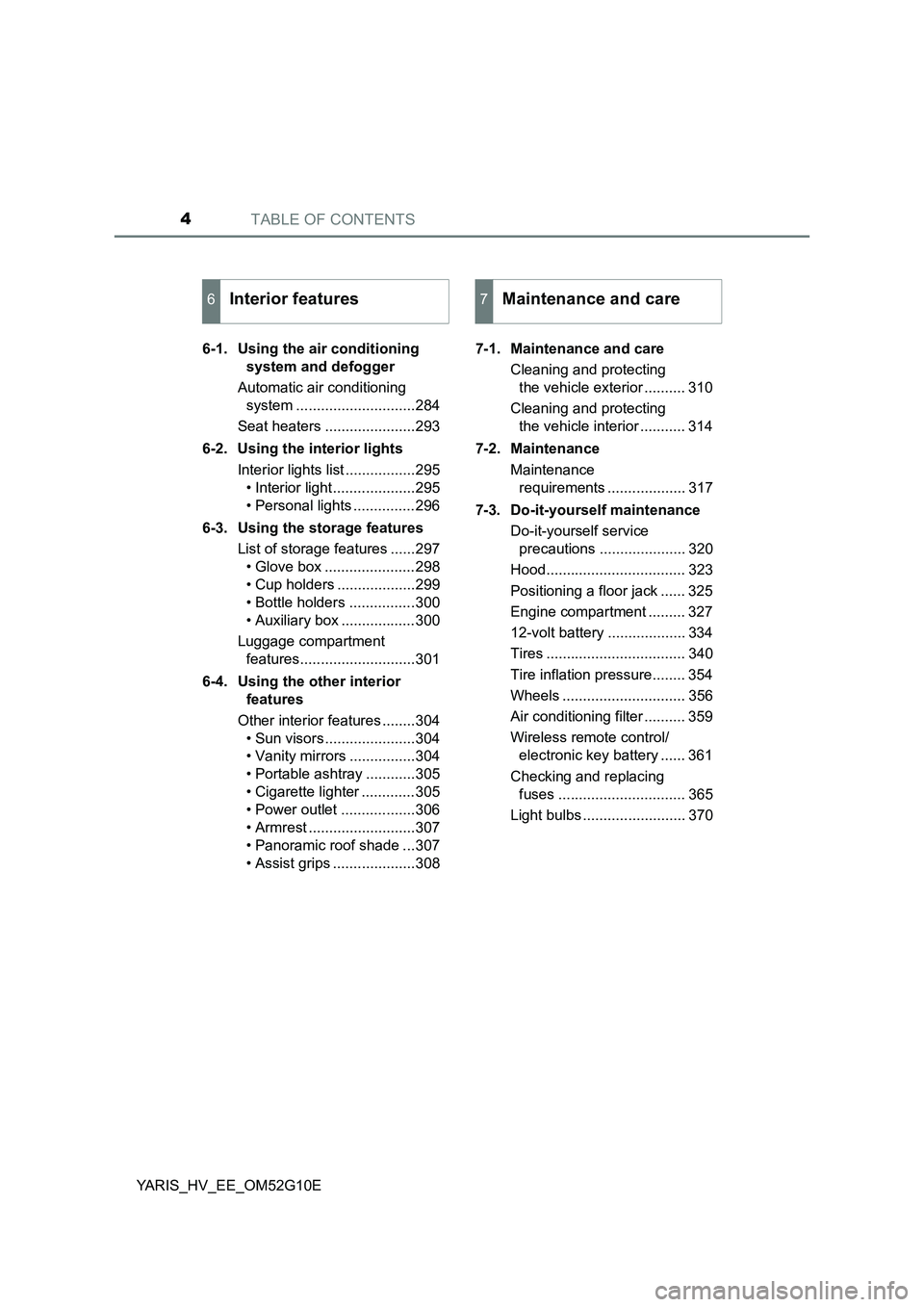
TABLE OF CONTENTS4
YARIS_HV_EE_OM52G10E
6-1. Using the air conditioning
system and defogger
Automatic air conditioning
system .............................284
Seat heaters ......................293
6-2. Using the interior lights
Interior lights list .................295
• Interior light ....................295
• Personal lights ...............296
6-3. Using the storage features
List of storage features ......297
• Glove box ......................298
• Cup holders ...................299
• Bottle holders ................300
• Auxiliary box ..................300
Luggage compartment
features............................301
6-4. Using the other interior
features
Other interior features ........304
• Sun visors ......................304
• Vanity mirrors ................304
• Portable ashtray ............305
• Cigarette lighter .............305
• Power outlet ..................306
• Armrest ..........................307
• Panoramic roof shade ...307
• Assist grips ....................308
7-1. Maintenance and care
Cleaning and protecting
the vehicle exterior .......... 310
Cleaning and protecting
the vehicle interior ........... 314
7-2. Maintenance
Maintenance
requirements ................... 317
7-3. Do-it-yourself maintenance
Do-it-yourself service
precautions ..................... 320
Hood.................................. 323
Positioning a floor jack ...... 325
Engine compartment ......... 327
12-volt battery ................... 334
Tires .................................. 340
Tire inflation pressure........ 354
Wheels .............................. 356
Air conditioning filter .......... 359
Wireless remote control/
electronic key battery ...... 361
Checking and replacing
fuses ............................... 365
Light bulbs ......................... 370
6Interior features7Maintenance and care
Page 5 of 492
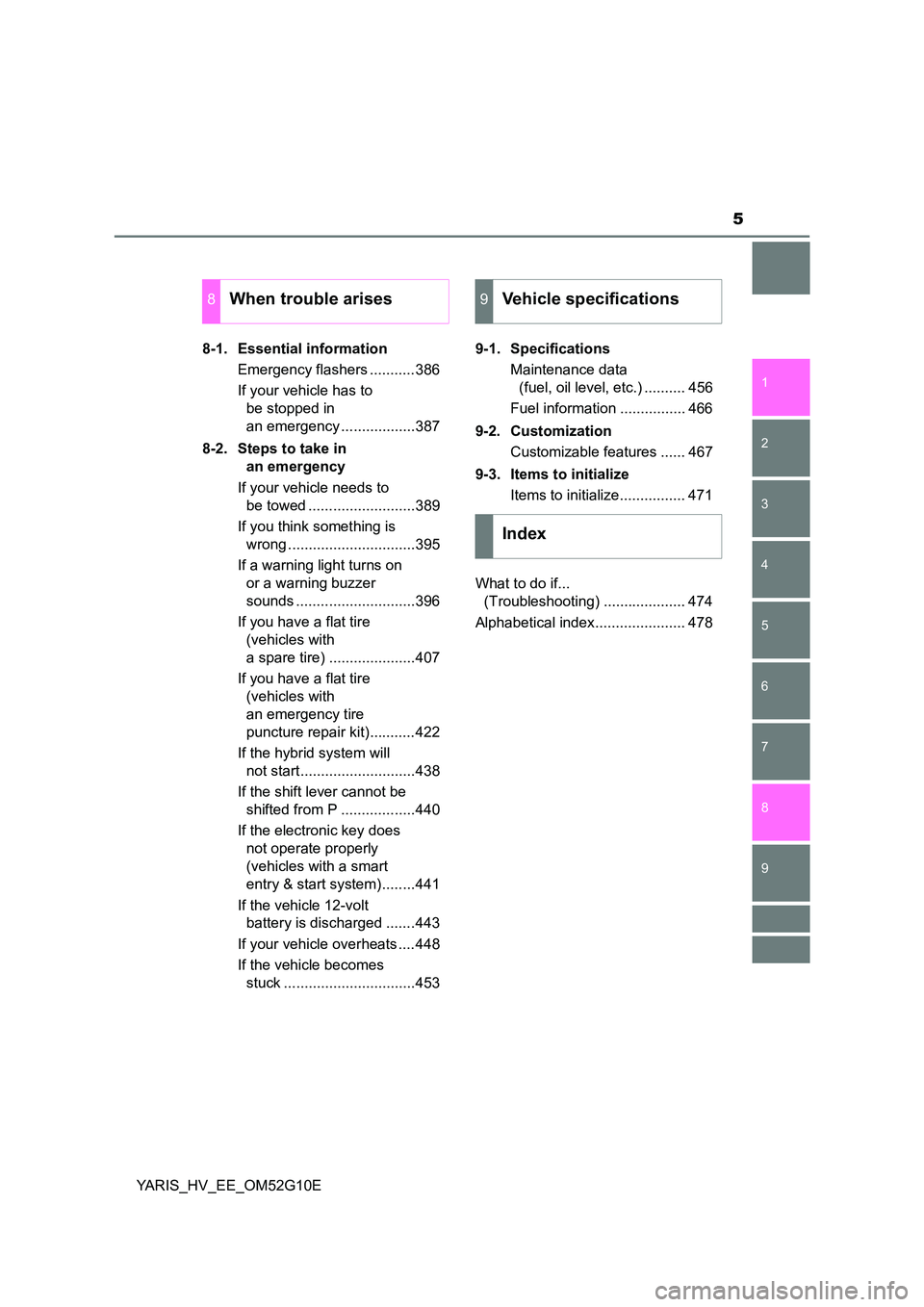
5
1
7
8
6
5
4
3
2
9
YARIS_HV_EE_OM52G10E
8-1. Essential information
Emergency flashers ...........386
If your vehicle has to
be stopped in
an emergency ..................387
8-2. Steps to take in
an emergency
If your vehicle needs to
be towed ..........................389
If you think something is
wrong ...............................395
If a warning light turns on
or a warning buzzer
sounds .............................396
If you have a flat tire
(vehicles with
a spare tire) .....................407
If you have a flat tire
(vehicles with
an emergency tire
puncture repair kit)...........422
If the hybrid system will
not start............................438
If the shift lever cannot be
shifted from P ..................440
If the electronic key does
not operate properly
(vehicles with a smart
entry & start system)........441
If the vehicle 12-volt
battery is discharged .......443
If your vehicle overheats ....448
If the vehicle becomes
stuck ................................453
9-1. Specifications
Maintenance data
(fuel, oil level, etc.) .......... 456
Fuel information ................ 466
9-2. Customization
Customizable features ...... 467
9-3. Items to initialize
Items to initialize................ 471
What to do if...
(Troubleshooting) .................... 474
Alphabetical index...................... 478
8When trouble arises9Vehicle specifications
Index
Page 13 of 492
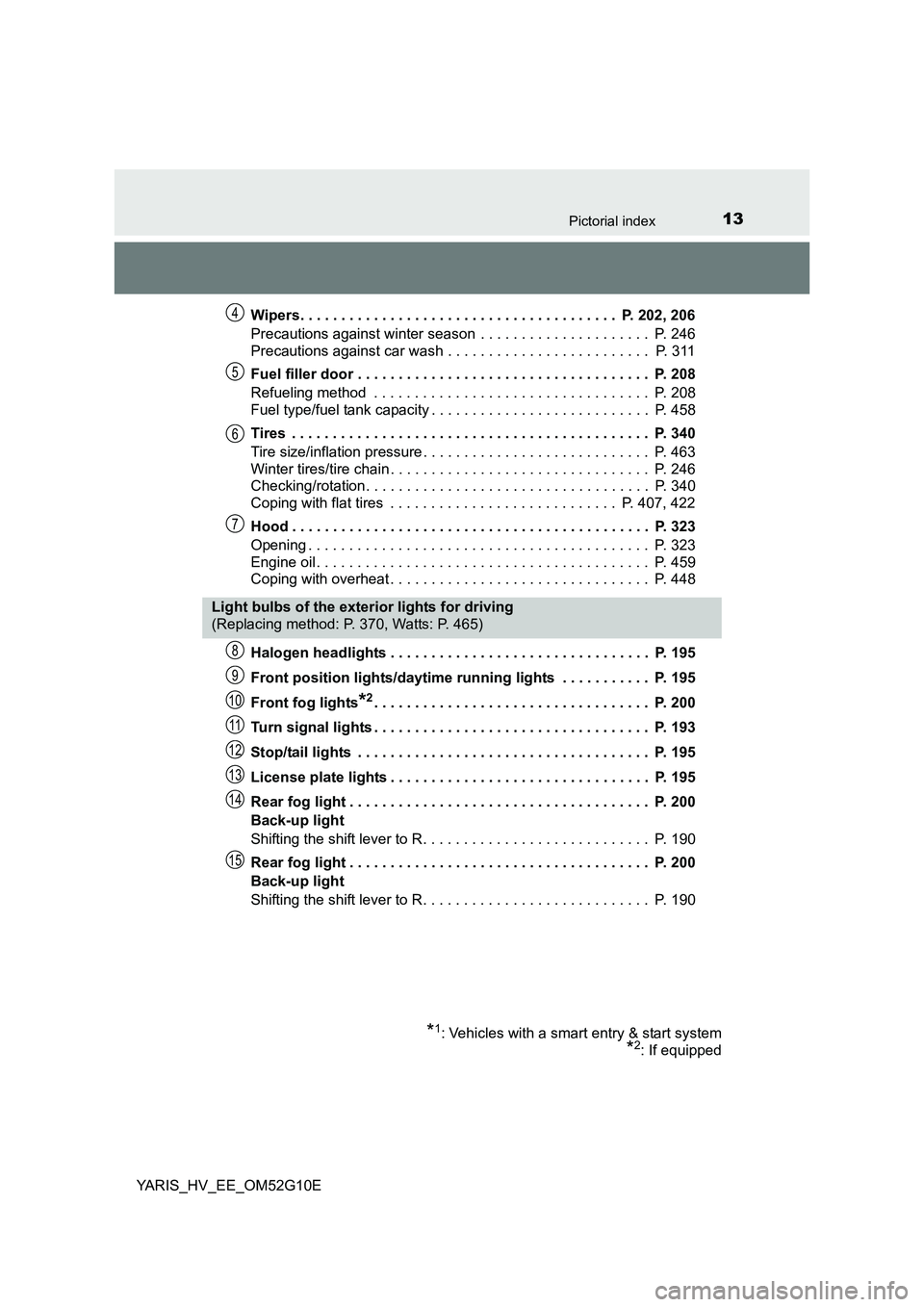
13Pictorial index
YARIS_HV_EE_OM52G10E
Wipers. . . . . . . . . . . . . . . . . . . . . . . . . . . . . . . . . . . . . . . P. 202, 206
Precautions against winter season . . . . . . . . . . . . . . . . . . . . . P. 246
Precautions against car wash . . . . . . . . . . . . . . . . . . . . . . . . . P. 311
Fuel filler door . . . . . . . . . . . . . . . . . . . . . . . . . . . . . . . . . . . . P. 208
Refueling method . . . . . . . . . . . . . . . . . . . . . . . . . . . . . . . . . . P. 208
Fuel type/fuel tank capacity . . . . . . . . . . . . . . . . . . . . . . . . . . . P. 458
Tires . . . . . . . . . . . . . . . . . . . . . . . . . . . . . . . . . . . . . . . . . . . . P. 340
Tire size/inflation pressure . . . . . . . . . . . . . . . . . . . . . . . . . . . . P. 463
Winter tires/tire chain . . . . . . . . . . . . . . . . . . . . . . . . . . . . . . . . P. 246
Checking/rotation. . . . . . . . . . . . . . . . . . . . . . . . . . . . . . . . . . . P. 340
Coping with flat tires . . . . . . . . . . . . . . . . . . . . . . . . . . . . P. 407, 422
Hood . . . . . . . . . . . . . . . . . . . . . . . . . . . . . . . . . . . . . . . . . . . . P. 323
Opening . . . . . . . . . . . . . . . . . . . . . . . . . . . . . . . . . . . . . . . . . . P. 323
Engine oil . . . . . . . . . . . . . . . . . . . . . . . . . . . . . . . . . . . . . . . . . P. 459
Coping with overheat . . . . . . . . . . . . . . . . . . . . . . . . . . . . . . . . P. 448
Halogen headlights . . . . . . . . . . . . . . . . . . . . . . . . . . . . . . . . P. 195
Front position lights/daytime running lights . . . . . . . . . . . P. 195
Front fog lights*2. . . . . . . . . . . . . . . . . . . . . . . . . . . . . . . . . . P. 200
Turn signal lights . . . . . . . . . . . . . . . . . . . . . . . . . . . . . . . . . . P. 193
Stop/tail lights . . . . . . . . . . . . . . . . . . . . . . . . . . . . . . . . . . . . P. 195
License plate lights . . . . . . . . . . . . . . . . . . . . . . . . . . . . . . . . P. 195
Rear fog light . . . . . . . . . . . . . . . . . . . . . . . . . . . . . . . . . . . . . P. 200
Back-up light
Shifting the shift lever to R. . . . . . . . . . . . . . . . . . . . . . . . . . . . P. 190
Rear fog light . . . . . . . . . . . . . . . . . . . . . . . . . . . . . . . . . . . . . P. 200
Back-up light
Shifting the shift lever to R. . . . . . . . . . . . . . . . . . . . . . . . . . . . P. 190
4
5
6
7
Light bulbs of the exterior lights for driving
(Replacing method: P. 370, Watts: P. 465)
*1: Vehicles with a smart entry & start system
*2: If equipped
8
9
10
11
12
13
14
15
Page 175 of 492
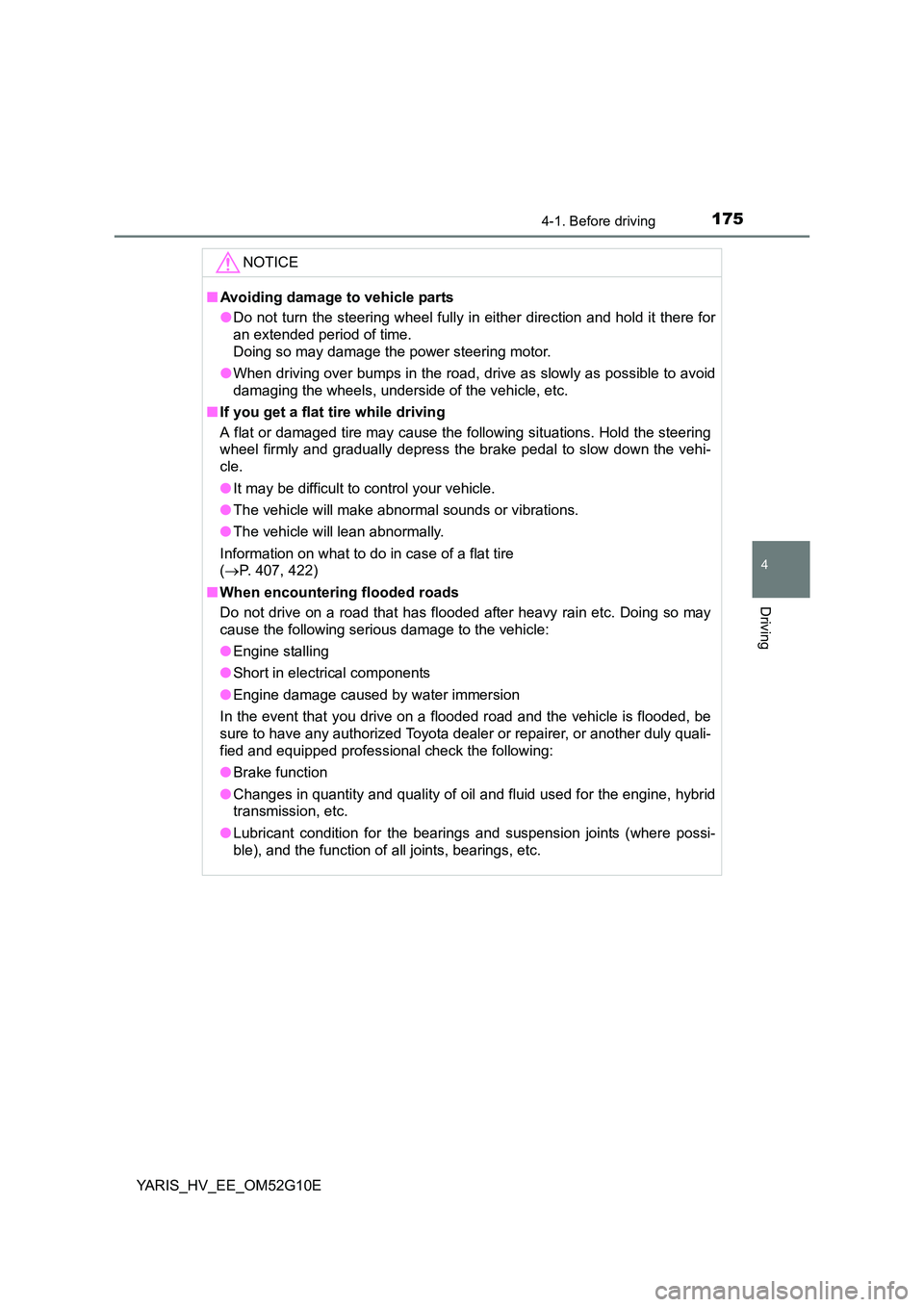
1754-1. Before driving
4
Driving
YARIS_HV_EE_OM52G10E
NOTICE
■Avoiding damage to vehicle parts
● Do not turn the steering wheel fully in either direction and hold it there for
an extended period of time.
Doing so may damage the power steering motor.
● When driving over bumps in the road, drive as slowly as possible to avoid
damaging the wheels, underside of the vehicle, etc.
■ If you get a flat tire while driving
A flat or damaged tire may cause the following situations. Hold the steering
wheel firmly and gradually depress the brake pedal to slow down the vehi-
cle.
● It may be difficult to control your vehicle.
● The vehicle will make abnormal sounds or vibrations.
● The vehicle will lean abnormally.
Information on what to do in case of a flat tire
( P. 407, 422)
■ When encountering flooded roads
Do not drive on a road that has flooded after heavy rain etc. Doing so may
cause the following serious damage to the vehicle:
● Engine stalling
● Short in electrical components
● Engine damage caused by water immersion
In the event that you drive on a flooded road and the vehicle is flooded, be
sure to have any authorized Toyota deale r or repairer, or another duly quali-
fied and equipped professional check the following:
● Brake function
● Changes in quantity and quality of oil and fluid used for the engine, hybrid
transmission, etc.
● Lubricant condition for the bearings and suspension joints (where possi-
ble), and the function of all joints, bearings, etc.
Page 226 of 492
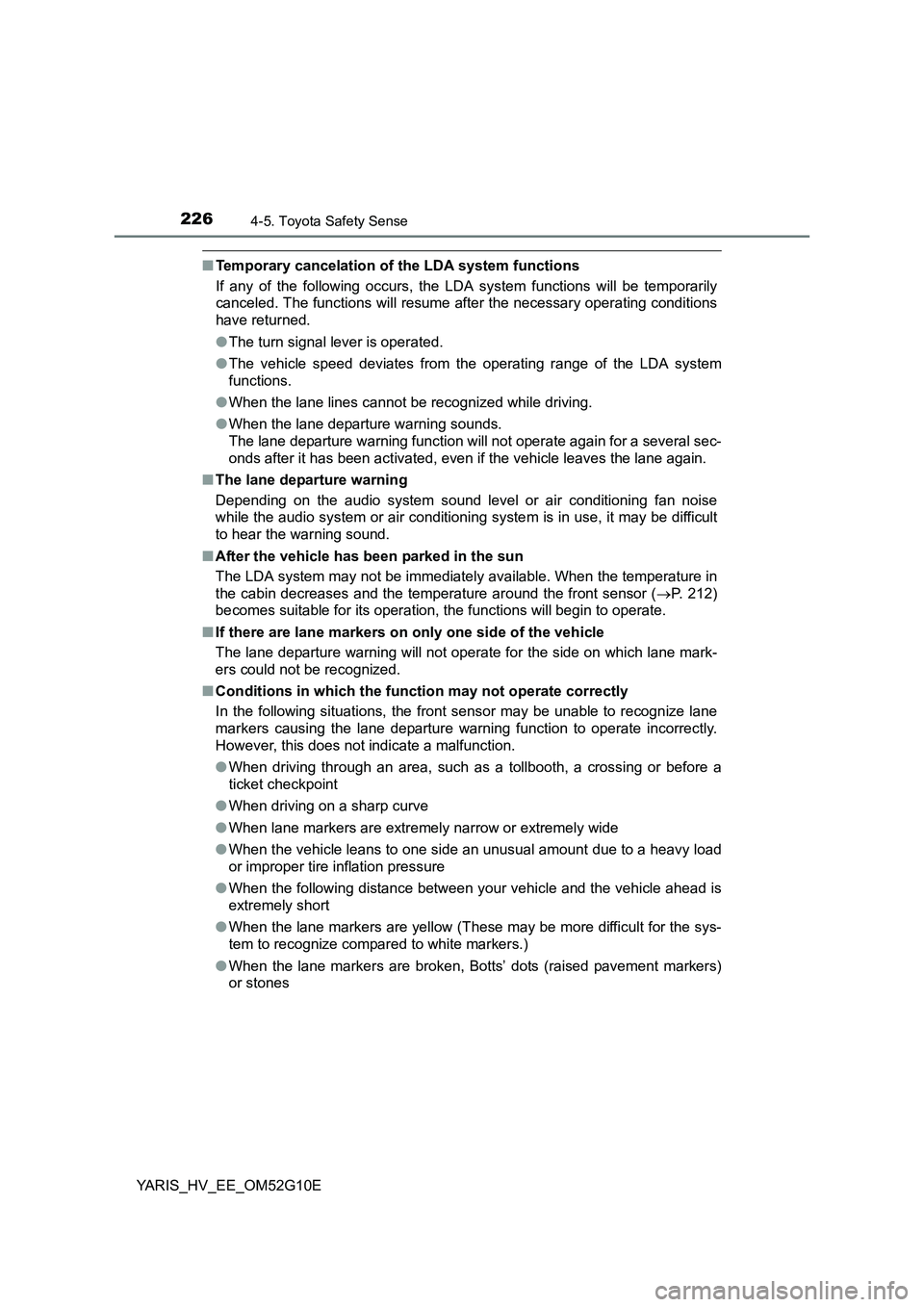
2264-5. Toyota Safety Sense
YARIS_HV_EE_OM52G10E
■Temporary cancelation of the LDA system functions
If any of the following occurs, the LDA system functions will be temporarily
canceled. The functions will resume after the necessary operating conditions
have returned.
● The turn signal lever is operated.
● The vehicle speed deviates from the operating range of the LDA system
functions.
● When the lane lines cannot be recognized while driving.
● When the lane departure warning sounds.
The lane departure warning function will not operate again for a several sec-
onds after it has been activated, even if the vehicle leaves the lane again.
■ The lane departure warning
Depending on the audio system sound level or air conditioning fan noise
while the audio system or air conditioning sy stem is in use, it may be difficult
to hear the warning sound.
■ After the vehicle has been parked in the sun
The LDA system may not be immediatel y available. When the temperature in
the cabin decreases and the temperature around the front sensor ( P. 212)
becomes suitable for its operation, the functions will begin to operate.
■ If there are lane markers on only one side of the vehicle
The lane departure warning will not operate for the side on which lane mark-
ers could not be recognized.
■ Conditions in which the function may not operate correctly
In the following situations, the front sensor may be unable to recognize lane
markers causing the lane departure warning function to operate incorrectly.
However, this does not indicate a malfunction.
● When driving through an area, such as a tollbooth, a crossing or before a
ticket checkpoint
● When driving on a sharp curve
● When lane markers are extremely narrow or extremely wide
● When the vehicle leans to one side an unusual amount due to a heavy load
or improper tire inflation pressure
● When the following distance between your vehicle and the vehicle ahead is
extremely short
● When the lane markers are yellow (These may be more difficult for the sys-
tem to recognize compared to white markers.)
● When the lane markers are broken, Botts’ dots (raised pavement markers)
or stones
Page 232 of 492
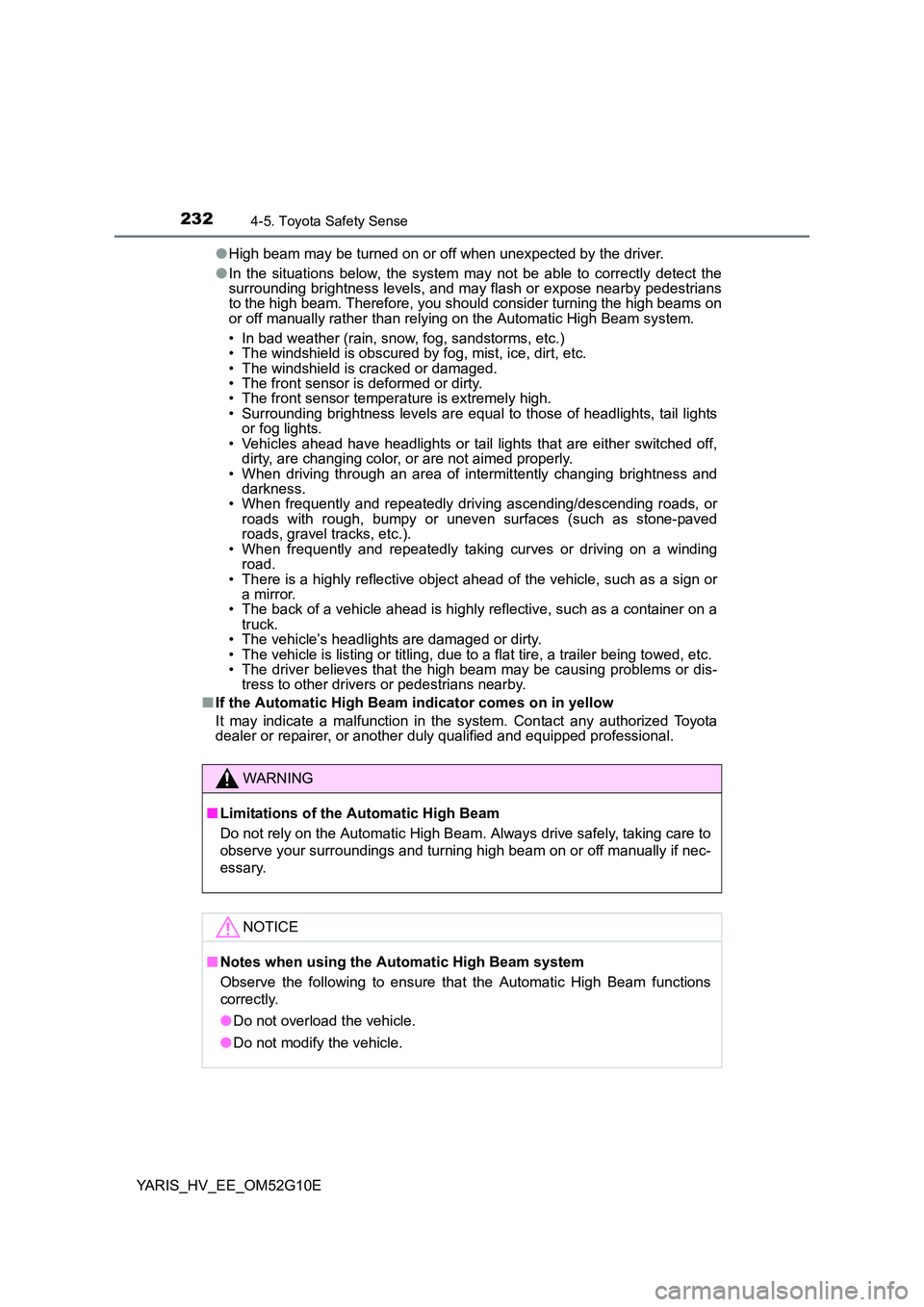
2324-5. Toyota Safety Sense
YARIS_HV_EE_OM52G10E
● High beam may be turned on or off when unexpected by the driver.
● In the situations below, the system may not be able to correctly detect the surrounding brightness levels, and may flash or expose nearby pedestrians to the high beam. Therefore, you shoul d consider turning the high beams on or off manually rather than relying on the Automatic High Beam system.
• In bad weather (rain, snow, fog, sandstorms, etc.) • The windshield is obscured by fog, mist, ice, dirt, etc.• The windshield is cracked or damaged.• The front sensor is deformed or dirty. • The front sensor temperature is extremely high. • Surrounding brightness levels are equal to those of headlights, tail lightsor fog lights.• Vehicles ahead have headlights or tail lights that are either switched off,dirty, are changing color, or are not aimed properly.• When driving through an area of intermittently changing brightness anddarkness. • When frequently and repeatedly driving ascending/descending roads, or roads with rough, bumpy or uneven surfaces (such as stone-pavedroads, gravel tracks, etc.).• When frequently and repeatedly taking curves or driving on a windingroad.• There is a highly reflective object ahead of the vehicle, such as a sign or a mirror. • The back of a vehicle ahead is highly reflective, such as a container on atruck.• The vehicle’s headlights are damaged or dirty.• The vehicle is listing or titling, due to a flat tire, a trailer being towed, etc.• The driver believes that the high beam may be causing problems or dis- tress to other drivers or pedestrians nearby.
■ If the Automatic High Beam indicator comes on in yellow
It may indicate a malfunction in the system. Contact any authorized Toyota dealer or repairer, or another duly qualified and equipped professional.
WARNING
■ Limitations of the Automatic High Beam
Do not rely on the Automatic High Beam. Always drive safely, taking care to
observe your surroundings and turning high beam on or off manually if nec-
essary.
NOTICE
■ Notes when using the Automatic High Beam system
Observe the following to ensure that the Automatic High Beam functions
correctly.
● Do not overload the vehicle.
● Do not modify the vehicle.
Page 242 of 492
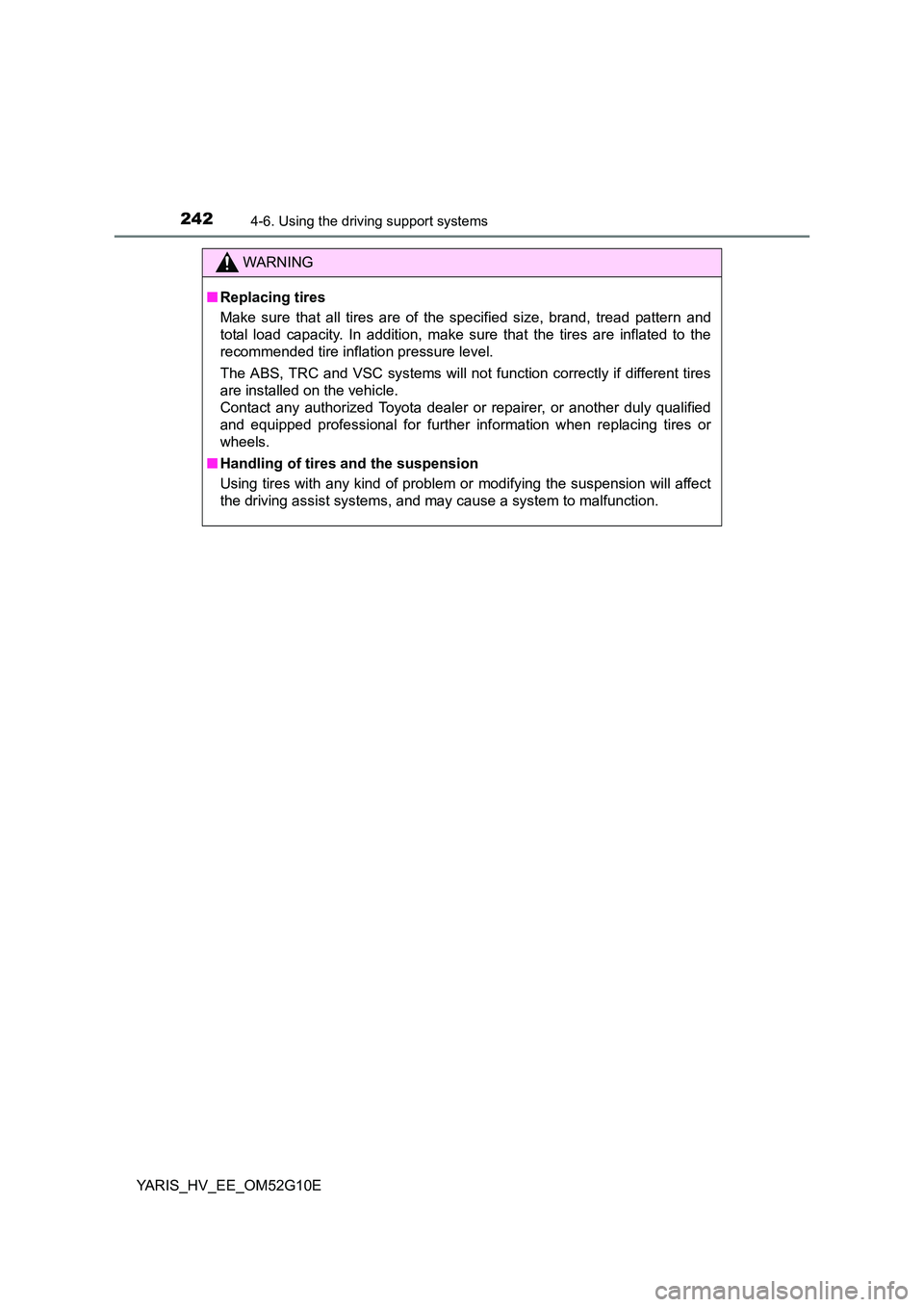
2424-6. Using the driving support systems
YARIS_HV_EE_OM52G10E
WARNING
■Replacing tires
Make sure that all tires are of the specified size, brand, tread pattern and
total load capacity. In addition, make sure that the tires are inflated to the
recommended tire inflation pressure level.
The ABS, TRC and VSC systems will not function correctly if different tires
are installed on the vehicle.
Contact any authorized Toyota dealer or repairer, or another duly qualified
and equipped professional for further in formation when replacing tires or
wheels.
■ Handling of tires and the suspension
Using tires with any kind of problem or modifying the suspension will affect
the driving assist systems, and may cause a system to malfunction.
Page 245 of 492
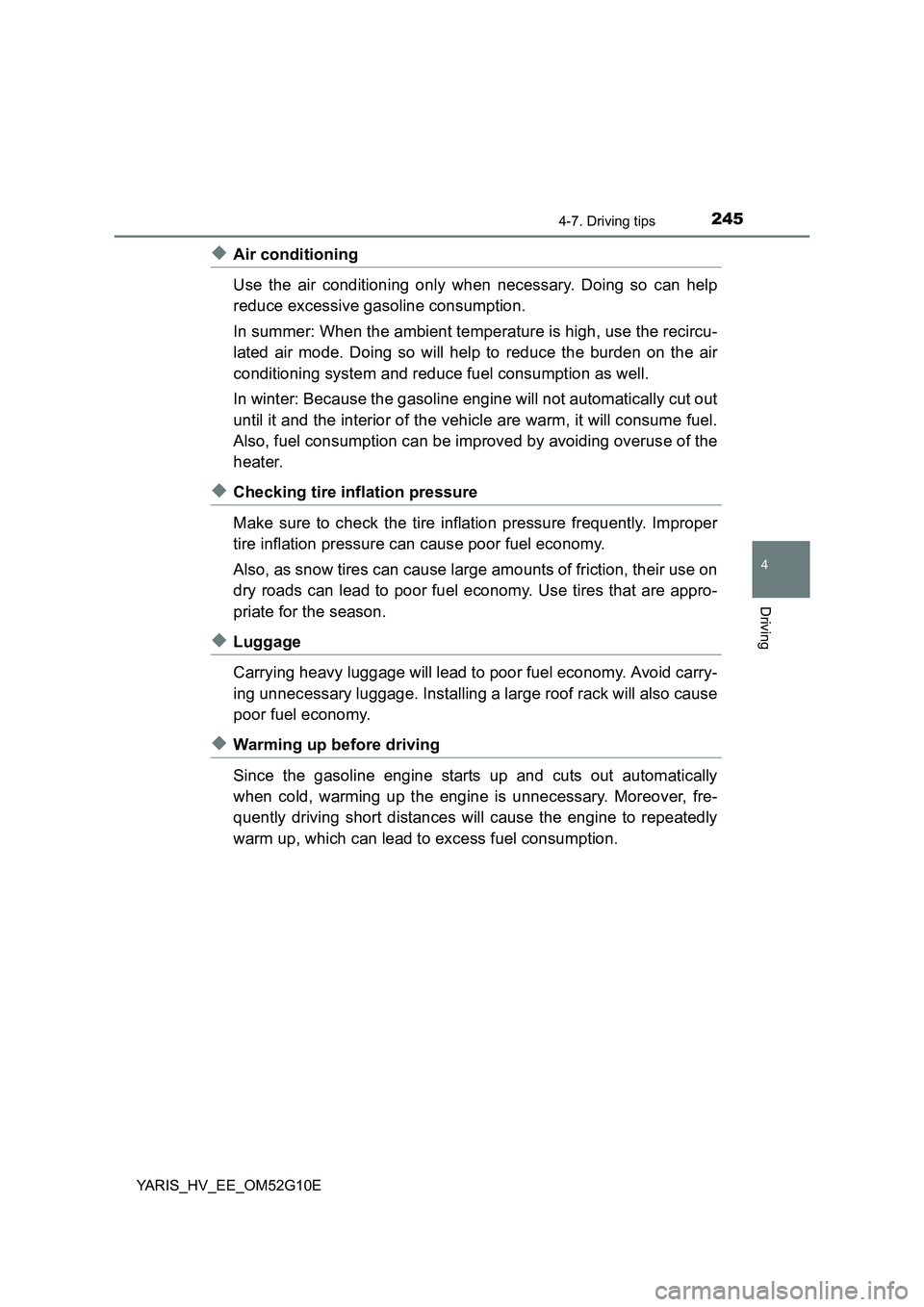
2454-7. Driving tips
4
Driving
YARIS_HV_EE_OM52G10E
◆Air conditioning
Use the air conditioning only when necessary. Doing so can help
reduce excessive gasoline consumption.
In summer: When the ambient temperature is high, use the recircu-
lated air mode. Doing so will help to reduce the burden on the air
conditioning system and reduce fuel consumption as well.
In winter: Because the gasoline engine will not automatically cut out
until it and the interior of the vehicle are warm, it will consume fuel.
Also, fuel consumption can be improved by avoiding overuse of the
heater.
◆Checking tire inflation pressure
Make sure to check the tire inflation pressure frequently. Improper
tire inflation pressure can cause poor fuel economy.
Also, as snow tires can cause large amounts of friction, their use on
dry roads can lead to poor fuel economy. Use tires that are appro-
priate for the season.
◆Luggage
Carrying heavy luggage will lead to poor fuel economy. Avoid carry-
ing unnecessary luggage. Installing a large roof rack will also cause
poor fuel economy.
◆Warming up before driving
Since the gasoline engine starts up and cuts out automatically
when cold, warming up the engine is unnecessary. Moreover, fre-
quently driving short distances will cause the engine to repeatedly
warm up, which can lead to excess fuel consumption.
Page 309 of 492
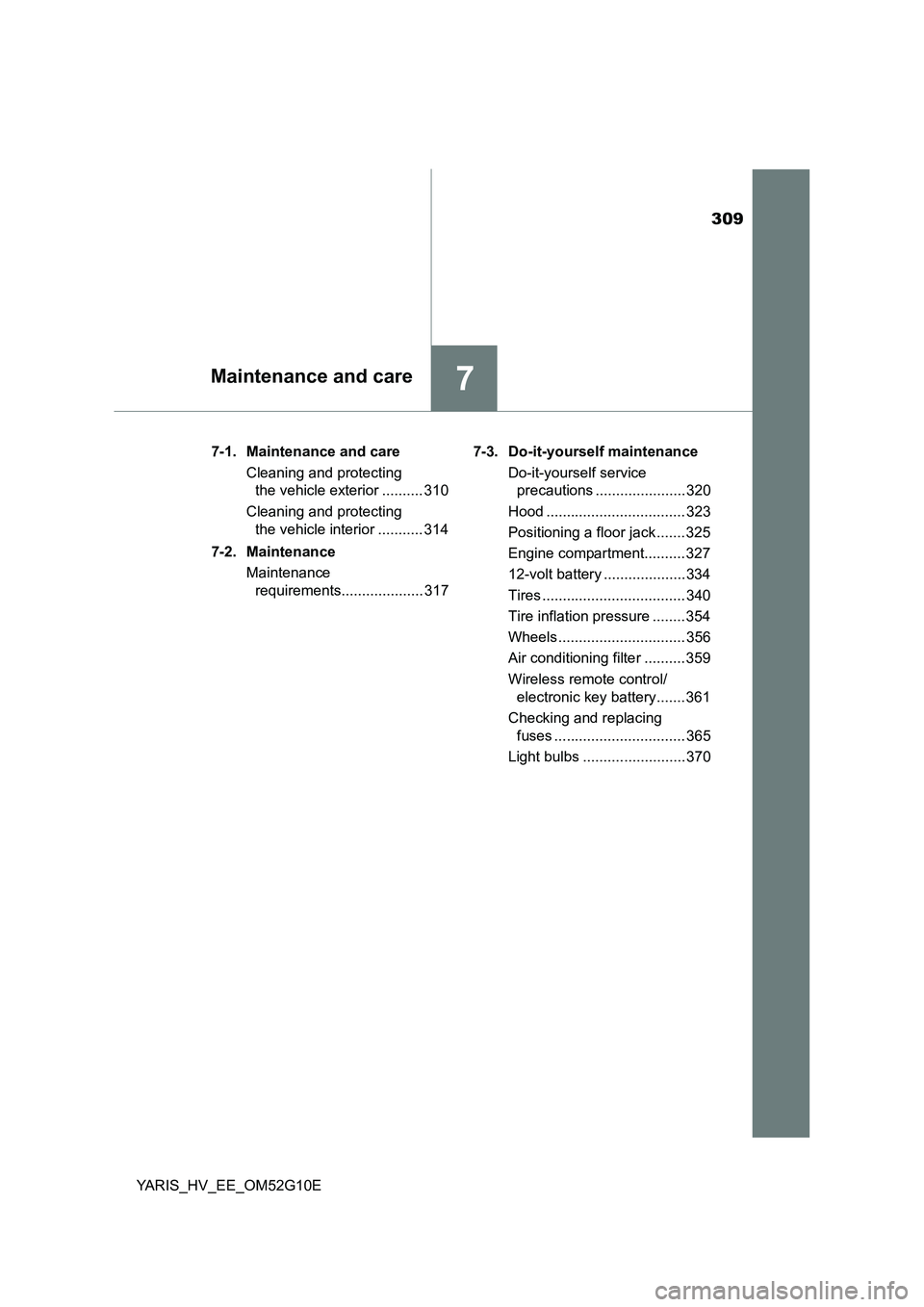
309
7Maintenance and care
YARIS_HV_EE_OM52G10E
7-1. Maintenance and care
Cleaning and protecting
the vehicle exterior .......... 310
Cleaning and protecting
the vehicle interior ........... 314
7-2. Maintenance
Maintenance
requirements.................... 317
7-3. Do-it-yourself maintenance
Do-it-yourself service
precautions ...................... 320
Hood .................................. 323
Positioning a floor jack ....... 325
Engine compartment.......... 327
12-volt battery .................... 334
Tires ................................... 340
Tire inflation pressure ........ 354
Wheels ............................... 356
Air conditioning filter .......... 359
Wireless remote control/
electronic key battery....... 361
Checking and replacing
fuses ................................ 365
Light bulbs ......................... 370
Page 318 of 492
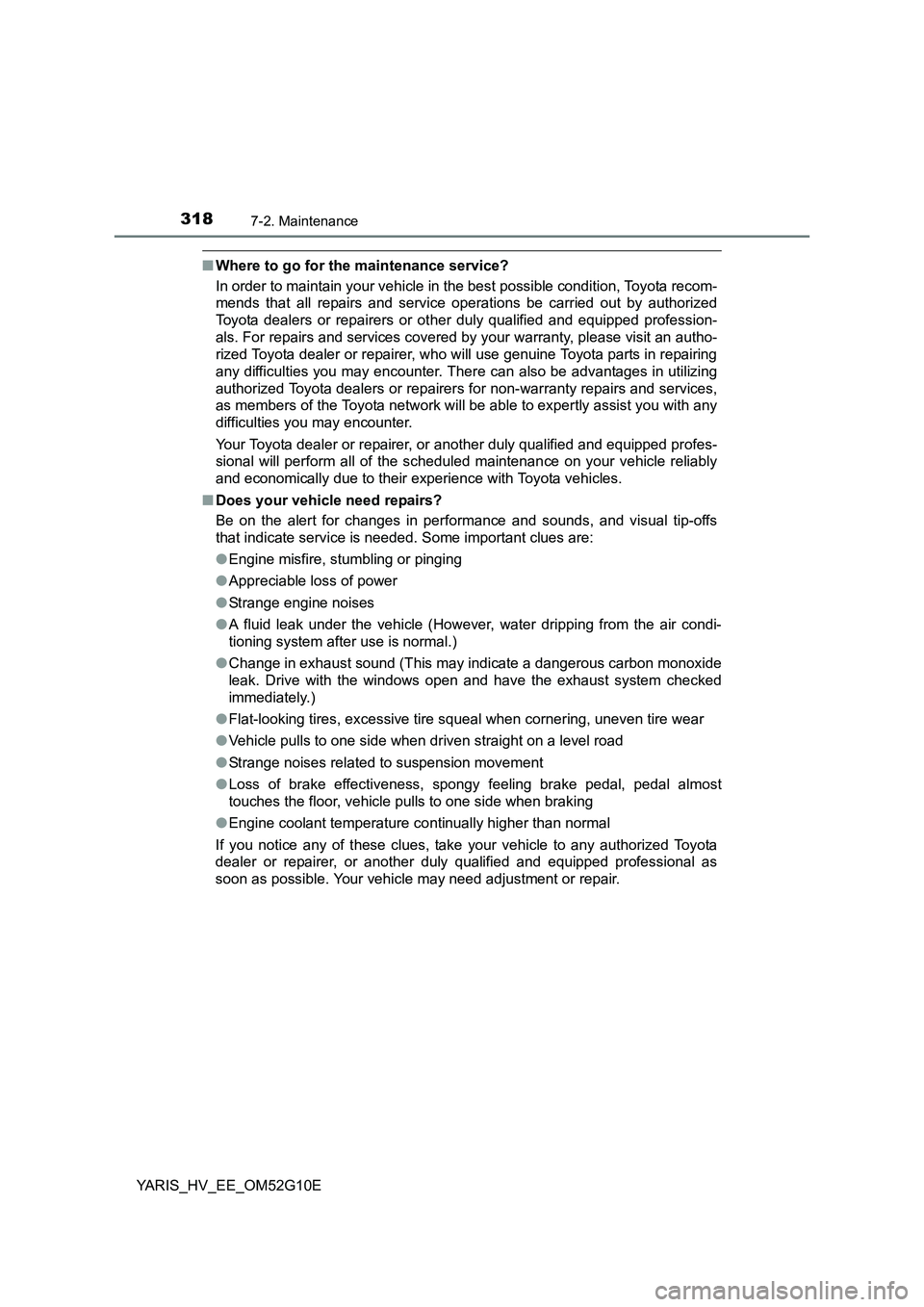
3187-2. Maintenance
YARIS_HV_EE_OM52G10E
■Where to go for the maintenance service?
In order to maintain your vehicle in the best possible condition, Toyota recom-
mends that all repairs and service operations be carried out by authorized
Toyota dealers or repairers or ot her duly qualified and equipped profession-
als. For repairs and services covered by your warranty, please visit an autho-
rized Toyota dealer or repairer, who will use genuine Toyota parts in repairing
any difficulties you may encounter. There can also be advantages in utilizing
authorized Toyota dealers or repairers for non-warranty repairs and services,
as members of the Toyota network will be able to expertly assist you with any
difficulties you may encounter.
Your Toyota dealer or repairer, or another duly qualified and equipped profes-
sional will perform all of the scheduled maintenance on your vehicle reliably
and economically due to their experience with Toyota vehicles.
■ Does your vehicle need repairs?
Be on the alert for changes in performance and sounds, and visual tip-offs
that indicate service is needed. Some important clues are:
● Engine misfire, stumbling or pinging
● Appreciable loss of power
● Strange engine noises
● A fluid leak under the vehicle (However, water dripping from the air condi-
tioning system after use is normal.)
● Change in exhaust sound (This may indicate a dangerous carbon monoxide
leak. Drive with the windows open and have the exhaust system checked
immediately.)
● Flat-looking tires, excessive tire squeal when cornering, uneven tire wear
● Vehicle pulls to one side when driven straight on a level road
● Strange noises related to suspension movement
● Loss of brake effectiveness, spongy feeling brake pedal, pedal almost
touches the floor, vehicle pulls to one side when braking
● Engine coolant temperature continually higher than normal
If you notice any of these clues, take your vehicle to any authorized Toyota
dealer or repairer, or another duly qualified and equipped professional as
soon as possible. Your vehicle may need adjustment or repair.